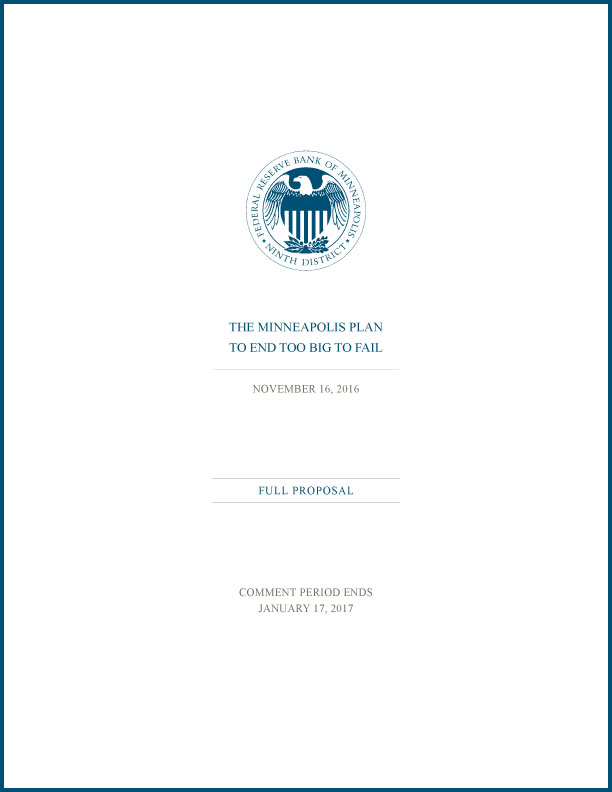This is the November 2016 draft of The Minneapolis Plan to End Too Big to Fail. See the final Plan here.
Plan Contents
- Section 1: Summary of the Minneapolis Plan to End Too Big To Fail
- Section 2: Recommendations: Key Support and Motivation
- Section 3: General Empirical Approach for the Capital and Leverage Tax Recommendations
- Section 4. Technical Calculations Supporting the Capital and Leverage Tax Recommendations
- Section 5: The Banking and Financial System Post-Proposal Implementation
- Section 6: Request for Comments on the Minneapolis Plan to End Too Big to Fail
- Appendix: Ending TBTF Initiative Process
- Key Questions about the Minneapolis Plan to End Too Big to Fail
The banking and financial system should look substantially different after implementation of our proposal than it would have looked otherwise. In particular, we envision a future where the financial system is much more stable and financial firms are not TBTF. While any estimation of the future is inherently uncertain, we would expect the following to occur. In particular:
- The small number of the largest banks that exist today will control a much smaller share of total banking assets in the future. These banks will have to break themselves up to become no longer systemically important firms as judged by the Treasury Secretary. At the same time, smaller banks that will have a bigger gap in their capital relative to larger banks should pick up market share. This will lead to a more-stable and less-concentrated banking sector.
- The largest banks will pose a much lower systemic risk to the economy. Most of these banks will become relatively smaller as just noted. Moreover, the manner in which they have reorganized will make them less systemically risky. Banks will have to receive the systemically not important designation to avoid the higher capital of Step 2, which encourages them to break themselves up in a manner that reduces systemic risk. Banks that fail to receive the designation of not being systemically important will have to issue a substantially higher amount of equity, making their failure remote. Again, the banking system will become more stable.
- Large but not systemically important banks will fund themselves with much higher levels of equity than they do today. This means that large banks have a lower chance of failure and that their failure poses lower risks of spillovers given that all other large firms will be exceptionally well-capitalized and thus can better absorb losses.
- Community banks will become more vibrant facing a more appropriate and risk-focused supervisory and regulatory regime. This regime will not give up on preventing community bank failures, nor will it stop consolidation arising from pure market forces, but it will reduce unnecessary costs.
- Shadow banks will be less systemically risky than they would be otherwise. The Treasury Secretary will have to review all designated shadow banks with assets greater than $50 billion to determine if they are systemically important. All of these shadow banks that are not systemically important will face a new shadow bank tax on borrowings that discourages them from taking on leverage. Thus, these firms will be less systemically risky than they would be otherwise.


